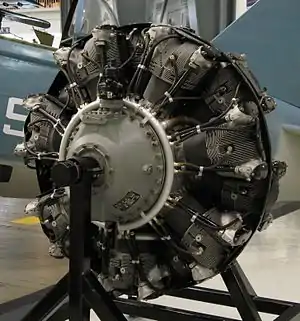Pratt & Whitney R-1535 Twin Wasp Junior
The Pratt & Whitney R-1535 Twin Wasp Junior was an engine used in American aircraft in the 1930s. The engine was introduced in 1932 as a 14-cylinder version of the 9-cylinder R-985. It was a two-row, air-cooled radial design. Displacement was 1,535 in³ (25.2 L); bore and stroke were both 5-3/16 in (131.8 mm).
| R-1535 Twin Wasp Junior | |
|---|---|
 | |
| Pratt & Whitney Twin Wasp Junior, at the National Museum of Naval Aviation, Pensacola, Florida | |
| Type | Radial engine |
| National origin | United States |
| Manufacturer | Pratt & Whitney |
| First run | 1932 |
Variants
- R-1535-11 - 750 hp (559 kW)
- R-1535-13 - 750 hp (559 kW), 825 hp (615 kW)
- R-1535-44 - 625 hp (466 kW)
- R-1535-72 - 650 hp (485 kW)
- R-1535-94 - 825 hp (615 kW)
- R-1535-96 - 825 hp (615 kW)
- R-1535-98 - 700 hp (521 kW)
- R-1535-SB4-G - 825 hp (615 kW)
Applications
- Bellanca 28-70
- Boeing XF6B
- Breguet 695
- Canadian Car and Foundry FDB-1
- Consolidated XB2Y
- Curtiss SBC-3 Helldiver
- Douglas O-46
- Fokker G.I (G.I The Wasp)
- Fokker D.XXI (Finnish licence-built series 4 and 5)
- Great Lakes BG
- Grumman F2F
- Grumman F3F-1
- Grumman XJF-1 Duck (prototype only)
- Grumman XSBF
- Grumman XSF-2
- Hughes H-1 Racer
- Miles Master
- Northrop A-17
- Northrop BT
- Northrop XFT-2
- Vought SBU Corsair
- Vought SB2U Vindicator
- Vought V-141
- Vought XF3U
- Vought XO4U-2
Engines on display
- There is a R-1535-96 on display at the New England Air Museum, Bradley International Airport, Windsor Locks, CT.[1]
- There is an R-1535 on display at the San Diego Air and Space Museum.
Specifications (R-1535-SB4-G)
Data from [2]
General characteristics
- Type: Fourteen-cylinder two-row supercharged air-cooled radial engine
- Bore: 5 3⁄16 in (131.8 mm)
- Stroke: 5 3⁄16 in (131.8 mm)
- Displacement: 1,534.9 in³ (25.153 l)
- Length: 53.27 in (1,353 mm)
- Diameter: 44.13 in (1,121 mm)
- Dry weight: 1,087 lb (493 kg)
Components
- Valvetrain: Two overhead valves per cylinder
- Supercharger: Single-speed centrifugal type supercharger, 11:1 step-up
- Fuel system: Two-barrel Stromberg carburetor
- Fuel type: 87 octane rating gasoline
- Cooling system: Air-cooled
- Reduction gear: Epicyclic gearing, 0.75:1
Performance
- Power output: 825 hp (615 kW) at 2,625 rpm for takeoff
- Specific power: 0.54 hp/in³ (24.45 kW/l)
- Compression ratio: 6.75:1
- Specific fuel consumption: 0.49 lb/(hp•h) (295 g/(kW•h))
- Oil consumption: 0.39 oz/(hp•h) (15 g/(kW•h))
- Power-to-weight ratio: 0.76 hp/lb (1.25 kW/kg)
See also
Related development
- Pratt & Whitney R-985 Wasp Junior
- Pratt & Whitney R-1340 Wasp
- Pratt & Whitney R-1830 Twin Wasp
- Pratt & Whitney R-2800 Double Wasp
- Pratt & Whitney R-4360 Wasp Major
Comparable engines
Related lists
References
Notes
- "Pratt & Whitney R-1535-96 Twin Wasp Junior"
- Tsygulev (1939). Aviacionnye motory voennykh vozdushnykh sil inostrannykh gosudarstv (Авиационные моторы военных воздушных сил иностранных государств) (in Russian). Moscow: Gosudarstvennoe voennoe izdatelstvo Narkomata Oborony Soyuza SSR.
Bibliography
- Gunston, Bill. World Encyclopedia of Aero Engines: From the Pioneers to the Present Day. 5th edition, Stroud, UK: Sutton, 2006.ISBN 0-7509-4479-X
- White, Graham. Allied Aircraft Piston Engines of World War II: History and Development of Frontline Aircraft Piston Engines Produced by Great Britain and the United States During World War II. Warrendale, Pennsylvania: SAE International, 1995. ISBN 1-56091-655-9
External links
| Wikimedia Commons has media related to Pratt & Whitney R-1535. |
This article is issued from Wikipedia. The text is licensed under Creative Commons - Attribution - Sharealike. Additional terms may apply for the media files.